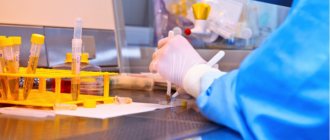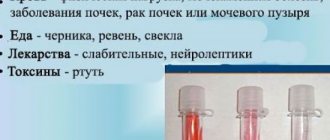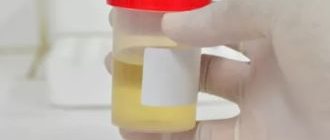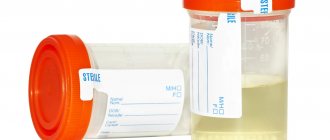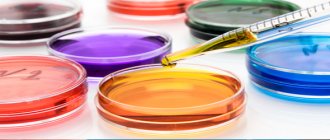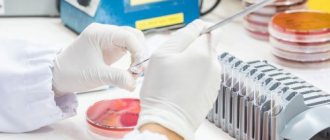To establish a diagnosis, the doctor prescribes the patient to take blood, urine, and rarely stool tests. TMA is not always sufficient to detect the disease. Having discovered pathological components in the biological fluid, the patient is recommended to have a urine test according to Nechiporenko. This is a common diagnostic method used to determine pathology of the genitourinary system. The researcher’s technique was put forward by the Soviet urologist A.Z. Nechiporenko, and was named after him.
Differences between the research method and OAM
Urinalysis according to Nechiporenko is a microscopic examination, which does not require the use of special equipment or a qualified specialist; it is available to any laboratory. After delivery, the urine is mixed, 10 ml is placed in a test tube, which is placed in a centrifuge and spun for three minutes to obtain a sediment. 1 ml of sediment is placed in a counting chamber, where the elements contained in urine are calculated. Afterwards, the quantity is multiplied by a coefficient to determine the number of elements in 1 ml.
The difference between the method and a general urine test is that the formed elements found in 1 ml of liquid are indicated, and not the amount visible in a microscope, which makes the result more reliable. This research method requires preparation.
When is the Nechiporenko test prescribed?
Indications for urine testing
This analysis is considered one of the most informative and easy to carry out urine samples that can detect various genitourinary infections. A special feature of this analysis is the ability to detect even hidden infections that do not outwardly manifest themselves.
Urinalysis according to Nechiporenko, the interpretation of which indicates a possible disease, is prescribed in the following cases:
- The patient underwent a general urine test and it showed the presence of red blood cells or white blood cells. A new analysis is necessary to obtain more accurate data that can direct the examination of the patient in the right direction.
- When specific elements - cylinders - are detected in the patient’s urine when performing a general analysis.
- If any pathology of the urinary and/or genital organs is detected.
- If necessary, control the ongoing treatment or surgical intervention.
The essence of the method is that in 1 ml of urine collected according to all the rules, the amount of elements important for establishing a diagnosis is determined:
- Red blood cells are blood cells that perform oxygen transport functions. In a normal state of health, a person should not have them in his urine, so their appearance indicates the presence of a very serious problem with the urinary organs.
- Leukocytes are special components of the blood, an increase in the number of which in the sample demonstrates the inflammatory infectious process in the body. These cells are directly related to the immune system, so an increase in their number demonstrates an immune response to the invasion of infectious agents.
- Cylinders are protein formations that appear in the renal tubules during the development of pathological processes.
In turn, cylinders can be found in various forms:
- Granular - appear as a result of the dissolution of the cells of the inner walls of the renal tubules (lysis).
- Hyaline - protein formations from primary urine.
- Red blood cells are blood cells that have clogged the kidney tubules.
- Waxy - arise from other forms of cylinders (granular or hyaline) with a long stay in the tubules.
- Epithelial - consisting of epithelium exfoliated from the renal tubule.
Carrying out this simple analysis helps in a simple and quick way to identify many serious diseases and begin their treatment as early as possible.
Preparing for analysis
Correct collection of material for research
In order for the urine test according to Nechiporenko to be as accurate and informative as possible, you must follow the rules for preparing for the test. Deciphering the analysis is very important for establishing the correct diagnosis, and for this, the test must be performed flawlessly.
The day before the test, it is recommended to make amendments and restrictions to your daily menu: give up meat products, sweets and baked goods, alcohol in various forms, carbonated drinks, foods, vegetables and fruits that can color urine - carrots, beets, and so on. . It is necessary to eliminate the use of medications, especially antibiotics, antimicrobials and diuretics, they can distort the picture.
If you are menstruating, you should refuse to give urine and reschedule it for another day. Before taking a urine sample, the genitals must be washed clean, but without using any detergents or disinfectants. Their inclusion in the sample can spoil it.
The container for analysis must be clean and sterile.
It is advisable to use a special container that can be purchased at a pharmacy, but a clean glass container will do just fine. The sample is taken from morning urine, that is, urine that was collected during the night. In this case, only its middle part is suitable for analysis. This means that you need to start and finish urinating in the toilet, and replace the container only in the middle of the process.
If you need to take a test from a small child who cannot yet control urination, you need to try to stimulate urination and not miss the moment to collect the sample. Urine for analysis should be brought to the laboratory as soon as possible after receipt. Otherwise, the sample will be spoiled by microorganisms multiplying in it.
What does a urine test according to Nechiporenko show?
What is revealed as a result of the calculation:
- The norm for urine analysis according to Nechiporenko is single red blood cells, which practically do not penetrate through the kidney apparatus.
- Leukocytes. If the number of cells is exceeded many times, inflammation is detected in the tissues of the urinary tract.
- Cylinders. The urine of a healthy person contains hyaline casts in minimal quantities; their increased number indicates illness. This is a protein, by the appearance of which one can judge kidney pathologies.
An increased value of erythrocytes and leukocytes according to Nechiporenko preliminarily diagnoses the following conditions:
- kidney inflammation;
- internal bleeding;
- oncological diseases of different locations;
- urolithiasis disease;
- inflammation of the urethra, bladder walls.
How to properly get tested for a child?
- Wash your child without soap.
- Option 1 - secure a urine bag around the external genitalia and wait for urination.
- Option 2 - put the child on an oilcloth and wait for him to start writing - place the prepared container under the stream of urine.
- You can stimulate urination reflexively: by stroking the back along the spine (for children under one year old) or by turning on the water in the tap (for children over one year old).
- Warn the doctor that the entire portion of urine has been submitted for analysis.
The results of the analysis according to Nechiporenko are compared with the norm - the optimal level of elements in 1 ml of urine:
- white blood cells – not higher than 2000;
- red blood cells – not higher than 1000;
- cylindrical bodies, which are markers of diseases of the renal parenchyma - no more than 20 units.
The norm for these indicators does not correlate with the age and gender of the patient, which is why the reference values are the same for adults and children of different sexes.
Deciphering the analysis when reference values are exceeded can reveal various pathological conditions in children and adults. The reasons for inflated data in the analysis results may also be hidden in diseases not related to the urinary system.
Table. Reasons for increased indicators in Nechiporenko analysis
| Increased performance | Diseases of the kidneys and urinary system | Blood pathologies | Other states |
| red blood cells | vein thrombosis, tuberculosis, polycystic disease, infarction, tumor, infection, severe pyelonephritis, tubulointerstitial nephritis, hemorrhagic nephritis, nephrocalcinosis, glomerulonephritis, urolithiasis, benign familial hematuria, as well as recurrent | hemophilia, leukemia, thrombocytopenia | scurvy (hypovitaminosis C), malignant hypertension, collagenosis, vasculitis, systemic lupus erythematosus (SLE), subacute infective endocarditis, congestive heart failure |
| leukocytes | tuberculosis, acute pyelonephritis, bladder cancer, nephrotic syndrome, glomerulonephritis, cystitis | fever, acute pancreatitis, appendicitis, SLE | |
| epithelial casts | infarction (acute renal tubular necrosis), glomerulonephritis, tubulointerstitial nephritis | heavy metal poisoning, eclampsia (during pregnancy) | |
| hyaline casts | chronic renal failure (CRF), nephrotic syndrome, proteinuria, pyelonephritis, glomerulonephritis, diabetic nephropathy | emotional stress, fever, dehydration, overheating, malignant hypertension | |
| waxy cylinders | amyloidosis, lipoid nephrosis, nephrotic syndrome, transplant rejection, diabetic nephropathy, chronic renal failure | myeloma accompanied by paraproteinuria | malignant hypertension |
| granular cylinders | renal tuberculosis, pyelonephritis, glomerulonephritis, acute and chronic renal failure | excessive physical activity, toxicosis (during pregnancy), malignant hypertension, chronic mercury vapor poisoning |
When deciphering a urine test according to Nechiporenko in men, in addition to the listed pathologies, prostatitis, vesiculitis or a prostate tumor may be detected.
Based on the interpretation of urine analysis according to Nechiporenko, diseases of the kidneys, urinary tract and other organs are diagnosed, and the effectiveness of the therapy used is monitored.
The maximum permissible content of white cells in urine is 2000 units per 1 ml of sample. Leukocytes are produced in the lymph nodes, bone marrow, and spleen and provide immunity. When the number of these cells in the urine exceeds the optimal values, this is considered evidence of a pathological condition.
The optimal number of leukocytes in the urine of patients based on OAM results is considered to be values from 0 to 10 units in the sample in the field of view under a microscope. An analysis carried out using the Nechiporenko method in a healthy woman gives less than 2000 units in 1 ml of urine. If the norm is significantly exceeded, women may be suspected of pathological conditions listed in the previous section, as well as untimely or improper hygienic treatment of the genitals or the use of cosmetics not intended for caring for the intimate area.
Normally, leukocytes in the urine of a pregnant woman can increase to a level of 10-15 units in the field of view according to OAM; with the Nechiporenko method, they focus on 2000 units per 1 ml. A significant excess of these values in pregnant women suggests the presence of pyelonephritis, cystitis, urethritis, nephritis and other diseases, and even the occurrence of stones in the urinary system.
Additional diagnostic procedures, such as ultrasound, will help clarify the diagnosis. To avoid errors in the results, pregnant women and women in general should carefully follow the preparation rules in order to correctly take a urine test according to Nechiporenko.
DETAILS: Urology in children under one year of age
Ideally, young patients should not have white cells in their urine, and most pediatricians adhere to this judgment. In childhood, according to many experts, the TAM norm correlates with the gender of the child - for boys it is 7 units, for girls - 10 according to the results of TAM and within 2000 according to Nechiporenko.
Shifts in the upward direction demonstrate the presence of a focus of inflammation in the child’s urinary system or in the appendix, or other pathologies. Often, errors occur because parents failed to collect urine samples correctly. A child with such test results should be examined more thoroughly and, if necessary, treated.
When red blood elements (more than 5 according to OAM and more than 1000 according to Nechiporenko) penetrate into the urine, a condition called hematuria occurs. This is an alarming symptom that makes you think about possible causes such as nephritis, nephrocalcinosis, urolithiasis, and cancer. In men, prostatitis, prostate adenoma, kidney tuberculosis, and urethral damage are often provoking factors.
The origin of an increased level of red cells in the urine of a child is usually associated with nephrocalcinosis, nephritis, pyelonephritis, cystitis, urethritis, and endocapillary glomerulonephritis. Less commonly observed are urolithiasis, hemophilia, cancerous tumors and the consequences of trauma to the urinary tract and organs.
Hematuria is an extremely serious fact in the pathological symptoms of children, therefore, after it has been established, it is necessary to immediately begin to search for the causes. During subsequent analysis, it is necessary to follow the algorithm of actions on how to donate urine using the Nechiporenko method, in order to avoid false positive answers.
Decoding
Normally, the Nechiporenko test contains a small amount of the above-described elements. For an adult, the indicators should be as follows (not higher):
- protein - absent;
- epithelial cells - single;
- red blood cells - 1000;
- leukocytes - 2000;
- cylinders - 20;
- bacteria - not detected.
At the stage of deciphering the urine test according to Nechiporenko, the doctor determines the presence or absence of a diagnosis, which allows treatment to begin in a timely manner. This method is not the only way to diagnose diseases.
General urine analysis
“General or clinical urine analysis” is usually called a study of material carried out within the framework of a healthcare medical institution - a laboratory. Thus, all the necessary characteristics of urine are assessed, and through its use microscopy of the sediment can be considered.
When visiting a therapist, a sick person will be advised to take the appropriate tests: urine and blood. A laboratory and clinical study carried out with a portion of urine will help evaluate:
- The color of the urine submitted for analysis.
- Specific gravity.
- Degree of transparency.
- Acidity level (ph balance).
Urinary examination allows you to determine epithelial cells, the presence of red blood cells, leukocytes, casts and bacteria, if any.
An analysis of this kind is prescribed to determine a huge number of diseases. It allows you to timely diagnose:
- Kidney diseases (nephritis, amyloidosis, tumors),
- Identification of primary signs of diseases (this is the reason why this test is prescribed during a preventive examination).
Who is the study for?
Urinalysis according to Nechiporenko is a secondary study. As mentioned above, it is indicated after passing the OAM, when it is clear that the person is unwell. The doctor prescribes a comprehensive diagnosis to determine the disease. Urinalysis according to Nechiporenko is indicated in the following cases:
- inflammatory processes of the urinary system;
- increase in red blood cells or leukocytes in the blood (diagnosis is carried out to determine the increase in values);
- assessment of the effectiveness of drug therapy;
- suspicion of bleeding;
- pregnant women when risks arise;
- children with suspected inflammatory processes in the kidneys or urinary system.
In what cases is Nechiporenko analysis prescribed?
The specialist prescribes this method of urine examination for the patient in cases where a general urine test shows:
- Leukocytes in urine.
- Presence of protein in urine.
- Traces of blood in the collected material.
- Increased levels of creatinine and urea in urine.
Here are some more reasons for prescribing such an analysis:
- Detection of both acute and chronic diseases affecting the genitourinary system and kidneys.
- Increased body temperature without any symptoms.
- Systemic diseases that are likely to affect the kidneys.
- During the treatment of diseases of the urinary system to specify treatment methods.
- When conducting general preventive examinations.
- Pregnancy - analysis helps to identify pathologies that threaten the normal bearing of a child.
How should I prepare a sample for analysis?
According to Nechiporenko’s method, a midline urine sample is collected. To do this correctly, you need to follow simple rules:
- On the eve of submitting a urine sample for examination, you should make sure that your diet does not contain spicy, salty, fatty foods or foods containing strongly coloring pigments, such as beets, carrots, blackberries, and the like. Some medications can also strongly color urine, so it is advisable to refrain from taking them. The period that elapsed between the last intake of these products and the test must be at least 12 hours;
- It is critically important to refrain from taking diuretics for 2 days before collecting a sample for analysis;
- Collect urine in the morning, with preliminary washing of the genitourinary organs and preferably without soap;
- An average portion of urine must be taken into a clean container or a special pharmaceutical container, and after collection, transported to the laboratory;
- Storage conditions for the analysis should be in a cool, unlit place, no more than two hours.
Video on the topic
How to get tested?
The process of collecting material for analysis usually raises many questions. And the preparation for such a study is much more serious than when passing a regular study. The day before the diagnosis you will have to go on a special diet. We will have to exclude:
- alcoholic drinks, including even low-alcohol options;
- hot seasonings and spices;
- different options for foods that can change the color of urine.
Women will have to refrain from collecting urine for testing during menstruation. Blood in the urine may be interpreted to the detriment of the patient. You should also remember that you should not carry out the analysis earlier than 7 days after cystoscopy and retrograde urography.
In a couple of days you will have to give up physical exercise, which can change the indicators of all physiological fluids in the body. On the eve of the study, you cannot use diuretics - in any form: neither as tablets, nor as drinks, nor as products.
If there are any active inflammatory processes in the genital area, it is worth rescheduling the study. You should also reschedule the test if you have had sexual intercourse.
The time for collecting analysis is the morning after waking up. The first urine must be collected. First you need to wash yourself, then start urinating in the toilet, then take the middle portion and finish in the toilet. For women, such preliminary preparation as the use of a tampon is required, which will block the entrance to the vagina and will not allow elements from the vagina to enter the urine. In this case, during urination, it is recommended to gently spread the labia with your fingers.
The child usually cannot fully understand the responsibility when collecting such an analysis, so the parent is responsible for it. Therefore, it is he who must wash the baby and make a fence either in a special container or on a clean oilcloth. Today, urine collection is carried out using medical disposable urine bags. The main thing is to gain enough volume.
Urine is collected in a clean and dry container - these are sold in all pharmacies today. The container with urine should be brought to the laboratory within two hours from the moment of collection. Do not store the jar in the refrigerator, freeze it, or leave it in direct sunlight.
The essence of the technique
This event is a priority in the diagnosis of various diseases of the genitourinary system.
With its help, it is possible to assess the level of kidney damage in certain pathologies. Through analysis, it is possible to identify the following diseases:
- neoplasms;
- poisoning;
- cystitis;
- pyelonephritis;
- glomerulonephritis;
- hypertension, etc.
- In cases of changes in the color of urine, its smell, transparency, the amount of single discharge and the occurrence of pain symptoms when urinating;
- If the results of the general analysis do not give clear results;
- If serious systemic illnesses are suspected, leading to a sharp decrease in kidney functionality;
- During preventive examinations;
- With a hereditary predisposition to genitourinary diseases;
- During the course of treatment to monitor the body's reaction.
The analysis is prescribed:
- after detecting an increased level of leukocytes or red blood cells in a general blood test;
- if there are casts in a general urine test;
- with pathology of the urinary system;
- to control the treatment performed.
When examining 1 ml of urine, formed elements are determined, namely leukocytes, erythrocytes, and cylinders.
- Leukocytes are blood cells responsible for immune control. An increase in their normal quantity always occurs with the development of inflammation.
- Red blood cells are blood cells that transport oxygen to organs and tissues. Normally they are not present in the urine; they appear in cases of serious pathology of the urinary organs.
- Cylinders are protein bodies formed during various pathologies in the kidney tubules.
Cylinders are classified into:
- granular, formed as a result of lysis of cells of the inner wall of the tubules;
- hyaline, which are formed from the protein of primary urine that does not have time to return to the blood;
- erythrocytes, which are red blood cells that have clogged the kidney tubules;
- waxy, which are formed from hyaline or granular as a result of their prolonged presence in the renal tubule;
- epithelial - detached epithelium of the renal tubule.
Rules for preparing for analysis
3 days before the study:
- stop eating plant foods that can change the color of urine (beets, carrots, etc.);
- Avoid taking diuretics and foods that have a diuretic effect (watermelon).
One day before the test:
- give up energy drinks and alcoholic drinks;
- eliminate physical activity and emotional stress.
Additional Information:
- urine analysis is carried out no earlier than on the 7th day after cystoscopy;
- collecting biomaterial during menstruation is permitted only in emergency cases.
